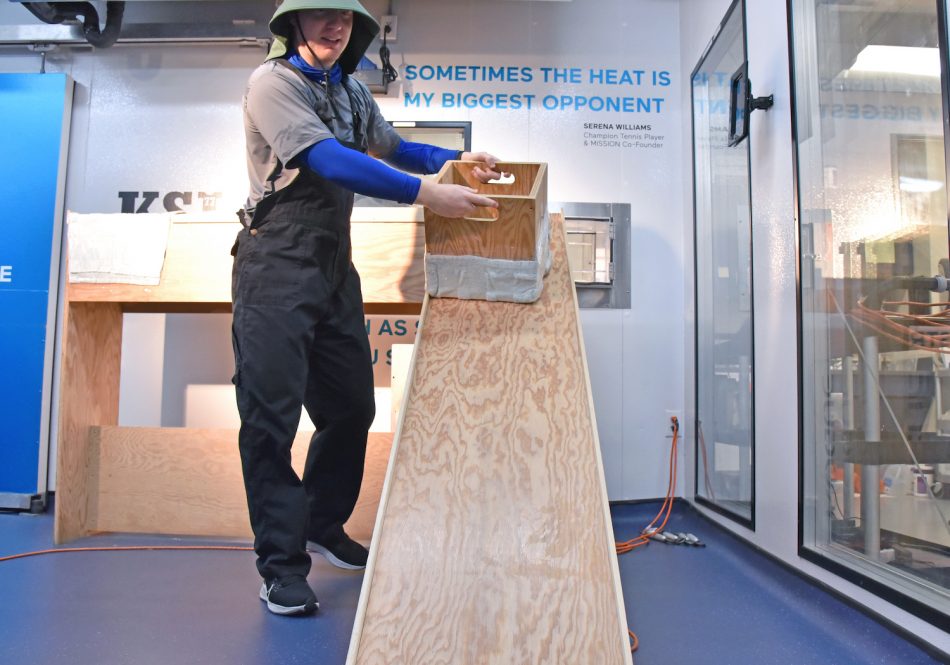The Korey Stringer Institute (KSI) within UConn’s College of Agriculture, Health and Natural Resources (CAHNR) has established itself as a leader in the field of athletic heat safety. But a branch of their research focuses on another vulnerable population – laborers.
 “There’s a lot of chatter right now amongst exercise scientists, climatologists, and everyone in between. We all want to understand how climate change is affecting workers’ health, but then also their productivity,” says Gabrielle Brewer, director of occupational safety and president of the heat safety and performance coalition at KSI.
“There’s a lot of chatter right now amongst exercise scientists, climatologists, and everyone in between. We all want to understand how climate change is affecting workers’ health, but then also their productivity,” says Gabrielle Brewer, director of occupational safety and president of the heat safety and performance coalition at KSI.
In a study published in Frontiers in Sports and Active Living, a group of KSI researchers reported that providing workers with access to heat mitigation strategies improves their health and productivity when working in simulated high-heat conditions.
Companies in industries where workers are regularly exposed to high heat, such as factories, construction, and agriculture, approached KSI with a question about how to keep workers safe in the heat and improve their productivity.
In the study, the KSI researchers had a group of active young men complete physical tasks, namely walking on a treadmill and moving boxes, in a specialized lab while applying a variety of heat mitigation strategies. The MISSION Heat Lab at UConn’s Korey Stringer Institute allowed for this unique testing.
On one end, participants received the gold-standard level of heat mitigation which includes unlimited access to water, regularly changing out ice packs in a cooling vest, working in the shade, and body cooling with towels. On the other, participants modelled the “worst case scenario” in which they had limited access to water and no other heat mitigation strategies.
The researchers also conducted a series of trials in between these two extremes.
“[We tested] the worst of the worst and the best of the best and then everything in between that led up to best working conditions in a simulation occupational setting,” Brewer says.
Throughout the trials, the researchers monitored participants’ internal body temperature, which is a key clinical indicator of heat strain, skin temperature, and heart rate. They also asked participants to rate how hot they felt, their level of fatigue, and how hard they felt they were working.
The most significant changes across all trials were between the worst- and best-case scenarios.
In the best-case scenario, workers had a lower internal body temperature and heart rate, as well as improved perceptions of their hotness, exertion, and fatigue. They were also able to complete approximately 14% more box lifts.
“That’s the data we want to share with companies. If they can keep their workers safe from a physiology perspective, maybe they’re not getting as hot, they’re not staying as hot for as long, and they’re being more productive at work on top of that, that’s a win for everyone,” Brewer says.
These metrics gradually improved in the intermediate trials as the researchers added more heat mitigation strategies. But the most dramatic effects were between the two ends of the spectrum.
Brewer explains that while some results were not statistically significant, they are still important for shareholders who value even minor improvements in productivity which can accumulate across a whole team of laborers working a full shift.
“If someone’s able to be a little bit better off, that’s a win for them, their health, their safety, their performance, their productivity, and that’s a win for the company in terms of output at the end of the day too,” Brewer says.
The researchers plan to pursue future studies that include both sexes in these conditions, as well as studying laborers working in their actual settings.
“The labor force is composed of a lot of women, and they need to be studied too,” Brewer says. “They are tremendously underrepresented in the research.”
Brewer emphasizes that the best-case scenario that showed the greatest physiological and productivity improvements may not work in every workplace, but that there are a variety of ways to practice heat mitigation strategies.
“There are a lot of options out there, and our data from this study shows that the more heat mitigation strategies you can combine, the more helpful it can be overall,” Brewer says.
This work relates to CAHNR’s Strategic Vision area focused on Enhancing Health and Well-Being Locally, Nationally, and Globally.
Follow UConn CAHNR on social media



